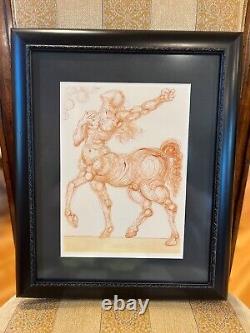
- Wood From Original
- Brand
- Alfa Romeo (13)
- Ancientsmithy (5)
- Andy Clancy Designs (9)
- Antique (21)
- Bbh Homes (15)
- Handmade (43)
- Japanese Netsuke (19)
- Jay Bigler, Maker (8)
- King (5)
- Lexus (10)
- Mercedes-benz (104)
- Nepal Forged (6)
- Original (20)
- Table (12)
- Threea (7)
- Toyokuni (7)
- Unknown (11)
- Volkswagen (5)
- Windlass Steelcraft (7)
- Wooden (22)
- ... (3549)
- Items Included
- Occasion
- Shape
- Size
- 12\ (2)
- 17 X 23cm (3)
- 3.5 X 4 In (2)
- 32 X 13cm (3)
- 36.5 X 24cm (9)
- 53 X 42cm (3)
- 8” (3)
- Assorted (2)
- Full (2)
- Giant (over 60in.) (6)
- King (3)
- Large (63)
- Large (up To 60in.) (28)
- Medium (114)
- Medium (up To 36in.) (121)
- Mittel (2)
- See Description (2)
- Small (44)
- Small (up To 12in.) (32)
- Standard (2)
- ... (3452)
- Warranty
Salvador Dali Centaur Inferno 25 Engraving from the Divine Comedy






Wood engraving in color after a watercolor on wove paper. Blindstamp of the editor, Jean Estrade, lower right margin. One of 100 wood engravings from the "Divine Comedy" series published in 1960 by Les Heures Claires, Paris.
From the collection of the editor. The 101 wood engravings from the'Divine Comedy' were executed over a 14 year period from 1951 to 1964. From 1951 to 1960, Dali painted 101 watercolors which were used as studies for the wood engravings. From 1960 to 1964, Raymond Jacquet created more than 3,000 wood blocks which were necessary for the complete Divine Comedy'' with the participation and final approval of Salvador Dali for each of the 101 engravings. Pre-owned, Excellent condition, no fading or yellowing, vibrant colors. Image size: 10 1/8' x 7 1/4. Framed size: 13.5"W x 16.5"H. Comes with a Certificate of Authenticity. For additional verification from Wentworth Gallery. This is a unique opportunity to own a piece of Dali's reinterpretation of Dante's epic, rendered in the surrealist master's distinctive and flamboyant style. Dali's "Centaur Inferno 25" is a visually arresting portrayal of one of the most compelling scenes from Dante Alighieri's "Inferno". The Centaur, a mythological creature symbolizing the fusion of human intellect and animal instinct, is depicted in Dali's signature surrealistic style.The use of vivid colors and imaginative details give the artwork a dreamlike quality, inviting the viewer on a journey through Dali's fantastical interpretation of Dante's vision. This work is in excellent condition, with the rich, vibrant colors maintained beautifully over time. It offers a unique insight into Dali's genius mind and his extraordinary ability to fuse literature, mythology, and surrealism into one cohesive artwork. The "Centaur Inferno 25" engraving comes with a certificate of authenticity, assuring its provenance and affirming its status as a valuable investment for art collectors. Born in Figueres, Catalonia, Spain, Dali is best known for his distinctive style and dreamlike, symbolic images.
His expansive artistic repertoire encompassed painting, graphic arts, film, sculpture, design and photography, amongst other mediums. His most iconic work, The Persistence of Memory (1931), with its melting clocks, showcases his exploration of subconscious imagery and the irrationality of the dream state.
Dali was also known for his eccentric public persona and his flair for self-promotion, which earned him equal parts fame and notoriety. Today, Dali's works are highly sought after by collectors and displayed in museums around the world, testifying to his enduring influence in the art world.

